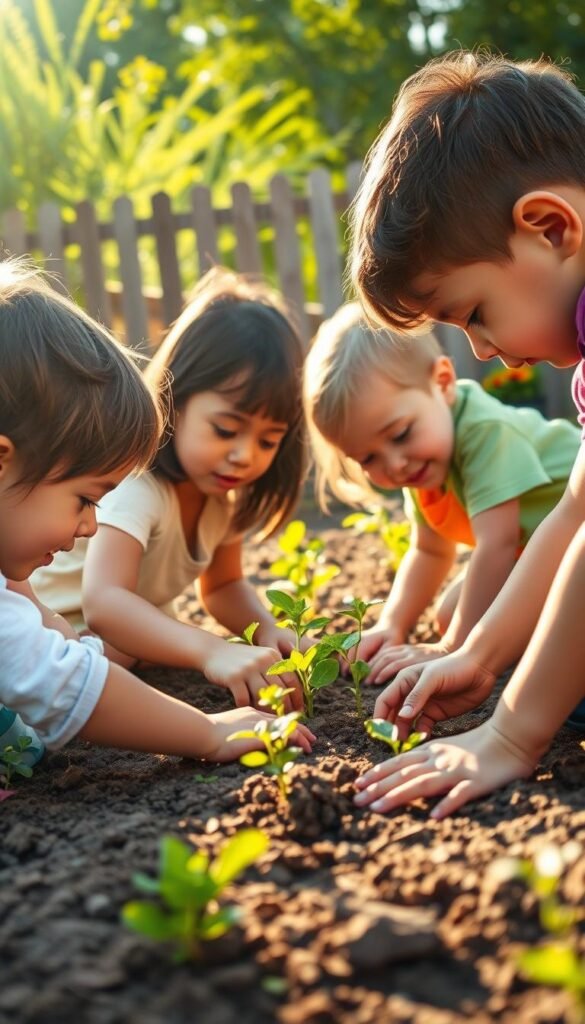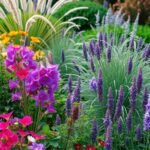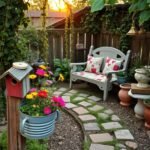Imagine turning your backyard into a classroom where dirt becomes art supplies and seeds transform into science experiments. Nature offers endless opportunities to help young minds grow while creating lasting memories together.
In today’s screen-filled world, digging in the soil provides a refreshing break. Even small spaces like patios or windowsills can host vibrant planters. Studies show families who nurture plants together build stronger connections and shared pride as they watch their efforts bloom.
Simple projects teach patience and problem-solving. A recycled container herb garden lets little hands measure soil and track growth stages. These moments quietly instill responsibility—without feeling like a chore.
This guide shares playful ways to explore seasons, textures, and ecosystems through hands-on adventures. You’ll discover how to adapt tasks for different ages and spaces, turning everyday routines into joyful discoveries.
Discover the Joy of Gardening with Your Kids
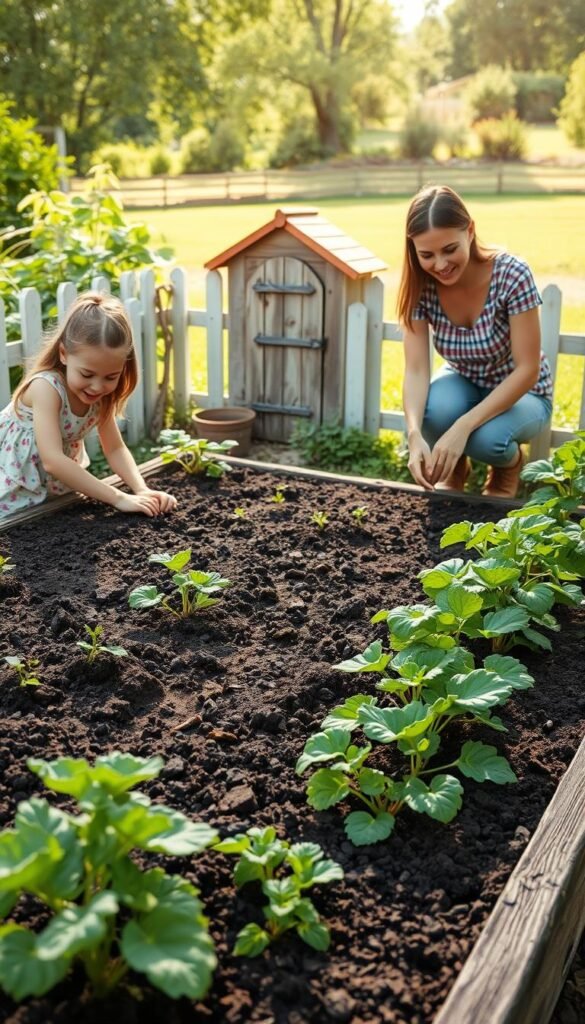
There’s something magical about watching a child’s eyes light up as they unearth their first carrot. Shared moments in the garden strengthen family ties while sparking wonder about how living things grow. Whether planting rainbow flowers or hunting for earthworms, these hands-on adventures turn ordinary afternoons into bonding opportunities.
Connecting with Nature as a Family
Start small—a windowsill planter with basil or a container of sunflowers lets children witness growth daily. Themed spaces like butterfly gardens become living classrooms. Research shows families who nurture plants together report improved communication and teamwork.
Building Lifelong Skills and Interests
Measuring soil depth teaches math basics. Watering schedules foster responsibility. A 2022 study found kids involved in outdoor activities develop better problem-solving abilities. These experiences plant seeds for future hobbies—or even careers in botany or ecology.
Upcoming sections will share playful ways to blend learning with dirt-covered fun. You’ll discover how to adapt projects for tiny balconies or sprawling yards, ensuring every family can cultivate joy together.
Getting Started with Easy Garden Projects

Transform a corner of your home into a green oasis where young gardeners can see results fast. These beginner-friendly ideas require minimal supplies and deliver big rewards, keeping energy levels high and attention spans engaged.
Simple Container and Windowsill Herb Gardens
Grab an old mason jar, yogurt cup, or small pot—anything with drainage holes works. Fill it with nutrient-rich soil and let little fingers press basil or mint seeds ¼ inch deep. Place it where sunlight streams through windows daily.
Water lightly every 2-3 days using a spray bottle for control. Within 7-10 days, sprouts emerge like magic. Chart their height on paper with colorful markers, turning care routines into a science experiment.
Planting Fast-Growing Seeds for Instant Success
Radishes and lettuce are superheroes of speed, ready to harvest in 3-4 weeks. Mix seeds with sand for easier handling, then scatter them in shallow soil trenches. Cover lightly and mist daily.
Create a growth diary: sketch leaves, count new shoots, or measure stems weekly. This tangible progress helps kids grasp cause-and-effect while celebrating tiny victories. Plus, crunchy homegrown snacks make the wait worthwhile!
Gardening Activities for Kids: Sprout Their Curiosity in the Yard

Grab some colorful pots and watch your little ones turn garden chores into treasure hunts! Start by letting them decorate containers with waterproof markers or stickers. Old boots, teapots, or painted cans become quirky homes for marigolds or cherry tomatoes. This artistic twist makes every plant feel like a personal masterpiece.
Mix up a soil science lab right in your yard. Give kids measuring cups to blend potting mix with compost, discussing how nutrients help plants grow. For tiny helpers, try a “mystery seed” game—hide different seeds in folded paper and guess what each will become. Check out these backyard gardening ideas for more playful experiments.
Creative Challenges That Grow Skills
Turn watering into a race with dollar-store squirt guns. Time how long it takes to fill a cup placed under leaves—they’ll learn precision while soaking the soil. Create a rainbow flower border by sorting petals by color, or build a pizza-themed planter with basil, oregano, and thyme.
| Activity | Skills Learned | Materials Needed |
|---|---|---|
| Seed Bingo | Pattern recognition | Seed packets, grid paper |
| Worm Hotel | Ecosystem basics | Clear jar, soil layers |
| Leaf Rubbings | Art & observation | Crayons, thin paper |
These projects aren’t just about growing plants—they’re about nurturing curiosity. Pair your adventures with community gardening projects to expand their green horizons. Who knew mud pies could teach responsibility and color theory simultaneously?
Outdoor and Indoor Gardening Projects for Every Season
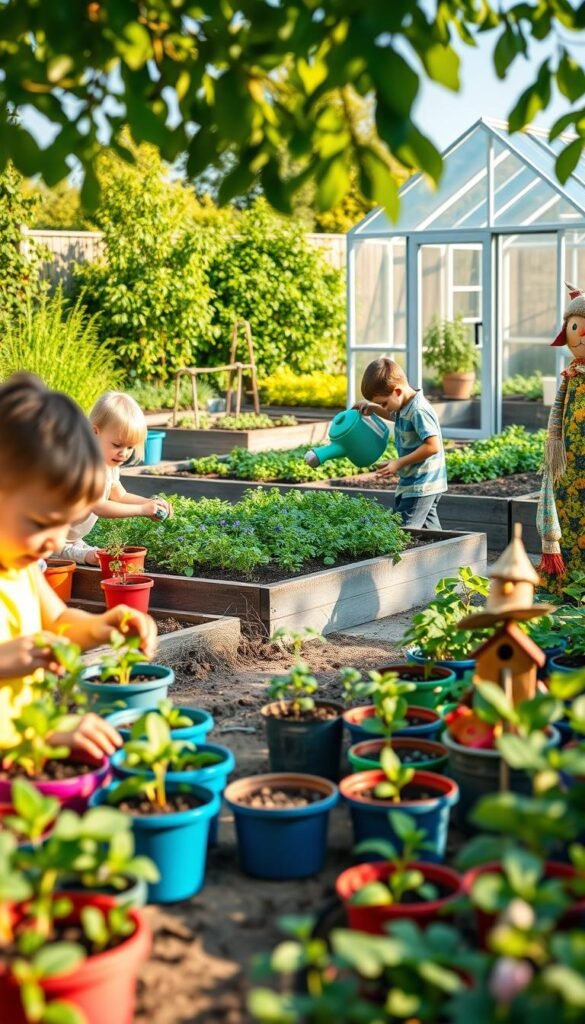
Transform your home into a year-round growing space where chilly winters and sunny summers each bring new discoveries. With smart planning, you can keep kids engaged with living science experiments no matter the weather outside.
Creating Indoor Green Spaces
Brighten dark winter days with a sunny windowsill herb garden. Use stackable planters to grow basil, parsley, and dwarf cherry tomatoes. Place a small grow light above lettuce greens for faster results—they’ll sprout in 5-7 days!
Try these space-smart ideas:
- Hanging mason jars with trailing pothos
- Egg carton seed starters for early spring
- Clear plastic bins as mini greenhouses
Exploring Outdoor Vegetable and Flower Beds
When warmer days arrive, create themed garden zones. Plant rainbow carrots in zigzag patterns or sunflowers that double as summer shade. For fall, let kids scatter wildflower seeds that bloom next spring.
| Season | Indoor Picks | Outdoor Stars |
|---|---|---|
| Winter | Microgreens, chives | Garlic (planted in fall) |
| Spring | Pea shoots, mint | Radishes, pansies |
| Summer | Aloe vera, thyme | Zinnias, bush beans |
| Fall | Wheatgrass, rosemary | Kale, asters |
Rotate plants with the seasons to teach natural cycles. A potted lemon tree indoors pairs perfectly with outdoor strawberry patches. Every month offers fresh ways to explore nature while beautifying your space together.
Creative Garden Themes to Spark Your Child’s Imagination

Turn your backyard into a storybook setting where plants become characters and flower beds transform into living landscapes. Themed spaces blend art with science, letting kids explore concepts through hands-on play. These immersive environments turn ordinary gardening into unforgettable adventures.
Alphabet Gardens: Growing Letters
Plant an A-to-Z wonderland using flowers and herbs that match each letter. Marigolds become “M,” while zucchini starts with “Z.” Little ones practice letter recognition while watering their leafy alphabet. This living puzzle grows taller each week, rewarding patience with colorful blooms.
Butterfly Havens: Wings & Blooms
Create a pollinator paradise with milkweed and coneflowers. Children will spot monarch caterpillars munching leaves and watch chrysalises form. Keep a journal to track visiting species—it’s biology class with fluttering teachers! Add a shallow water dish with rocks for butterfly pit stops.
Dinosaur Ecosystems: Prehistoric Play
Ferns and horsetails turn your yard into Jurassic Park. Bury “dino eggs” (painted stones) for excavation missions. Discuss how these plants survived millions of years, linking past and present. It’s history lessons meets imaginative role-play—complete with roaring T-Rex impressions!
These themes turn gardening into multi-day explorations. Rotate activities: Mondays for watering, Fridays for discoveries. You’ll create lasting memories while sneaking in lessons about nature’s cycles. Who knew learning could sprout from a packet of seeds and some craft supplies?
Interactive Garden Games and Playful Projects

Who needs board games when your backyard becomes the ultimate play zone? Turn ordinary afternoons into magical quests where every leaf holds secrets and tiny worlds come alive. These adventures blend imagination with nature, letting kids explore while developing keen observation skills.
Enchanted Miniature Worlds
Create fairy gardens using thrifted teacups or shallow containers. Let children arrange pebble paths, twig bridges, and mushroom-shaped rocks. Add drought-tolerant succulents like hens-and-chicks as “magic trees.” This great way to reuse old toys sparks storytelling while teaching plant care basics.
Treasure Hunts Under the Sky
Design a scavenger hunt list with items like:
- A heart-shaped leaf
- Smooth stone with stripes
- Yellow flower with five petals
Hide painted rocks among bushes for extra excitement. Time challenges encourage quick thinking—perfect for burning energy while learning about local flora.
| Activity | Developed Skills | Materials |
|---|---|---|
| Fairy House Building | Creativity, fine motor | Pinecones, acorns, moss |
| Bug Bingo | Observation, focus | Printed cards, magnifiers |
| Rainbow Hunt | Color recognition | Paint chips, baskets |
For families with limited space, try container gardening to create portable play zones. These projects prove that dirt and laughter make the best recipe for unforgettable childhood memories!
Hands-On Learning and Garden Art for Kids
Unleash your child’s inner artist using petals, pebbles, and a dash of imagination! Garden crafts blend creativity with science, turning fallen leaves into masterpieces and old jars into buzzing habitats. These messy adventures teach color theory through nature’s palette while fostering pride in handmade creations.
Garden Crafts and Nature Art Projects
Start with pressed flower bookmarks. Collect colorful blooms, layer them between paper sheets, and stack heavy books for 3 days. For instant results, make leaf rubbings using crayons and printer paper—perfect for rainy days.
Transform twigs and pinecones into seasonal mobiles. Tie findings with yarn and hang near windows to catch sunlight. This explores balance and natural patterns while reusing materials.
Personalizing Pots and Garden Decorations
Let young creators design their pot masterpieces:
- Clean terracotta pots with damp cloths
- Paint base colors using acrylics
- Add stickers or handprints after drying
Turn mason jars into mini ecosystems. Layer pebbles, soil, and moss, then add tiny figurines. These terrariums teach water cycles through condensation observations.
| Project | Materials | Skills Developed |
|---|---|---|
| Seed Paper | Recycled paper, wildflower seeds | Recycling concepts, fine motor |
| Pinecone Feeders | Peanut butter, birdseed | Ecology, patience |
| Rock Markers | Smooth stones, acrylic paint | Labeling, color mixing |
Add functional art like citrus-slice bird feeders. Thread orange halves with string and fill with seeds. Watch feathered friends visit while discussing local bird species. Every project becomes a stealth lesson in textures, sustainability, and creative problem-solving!
Practical Tips for Creating a Kid-Friendly Garden Space
Designing a garden that’s both safe and exciting for young explorers starts with the right tools and spaces. Focus on creating areas where kids can dig, plant, and observe without constant supervision. A well-planned layout prevents accidents while encouraging independence—think wide pathways and clearly marked growing zones.
Choosing Child-Sized Tools and Safe Materials
Opt for lightweight tools with rounded edges—plastic trowels and mini rakes work best for small hands. Avoid chemical-treated materials; untreated wood planters and organic potting soil keep plants and people safe. For affordable DIY hydroponic projects, use food-grade containers instead of PVC pipes.
Create a dedicated spot just for them: a 3×3-foot raised bed or colorful pots on a low table. Include sensory elements like fuzzy lamb’s ear leaves or fragrant mint. Rotate seeds seasonally to maintain interest—sunflowers in summer, pansies in fall.
| Tool Type | Child-Friendly Features | Safety Tips |
|---|---|---|
| Watering Can | 1-liter capacity, two handles | Check for BPA-free plastic |
| Gloves | Stretchy cuffs, breathable fabric | Avoid latex if allergic |
| Kneeling Pad | Waterproof foam | Store indoors when not used |
Add playful features like a bird feeder made from recycled bottles or painted rocks as markers. These touches make care routines feel like play while teaching responsibility. Always keep a wash station nearby—a simple bucket with soapy water prevents muddy messes indoors!
Wrapping Up Your Garden Adventures
Every muddy handprint tells a story of discovery in your family’s green garden journey. From painted pots bursting with herbs to “aha!” moments when seeds sprout, these shared activities weave learning into laughter. Whether you’ve built a jar terrarium or tracked summer sunflowers, each project plants pride in young minds.
Celebrate small wins—the first radish plucked or a leaf-rubbing masterpiece on paper. Your spot of dirt evolves with every season, offering fresh puzzles to solve. Rainy days become indoor experiments with recycled materials, while sunny afternoons invite bug hunts under open skies.
Keep that momentum growing! Swap stories with other families or try new supplies like glow-in-the-dark rocks for nighttime magic. Remember: nurturing plants together isn’t just about blooms—it’s how kids grow roots in nature’s world.
Ready for your next opportunity? Grab those tiny shovels and let curiosity dig deeper. What vibrant adventure will you cultivate tomorrow?

